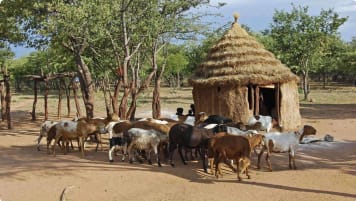Africa's Gold Coast and the Gold Trade
Article for travellers exploring West Africa and Ghana about the Portuguese and Gold. An Antipodean travel company serving World Travellers since 1983 with small group educational tours for senior couples and mature solo travellers.
16 Jul 24 · 15 mins read
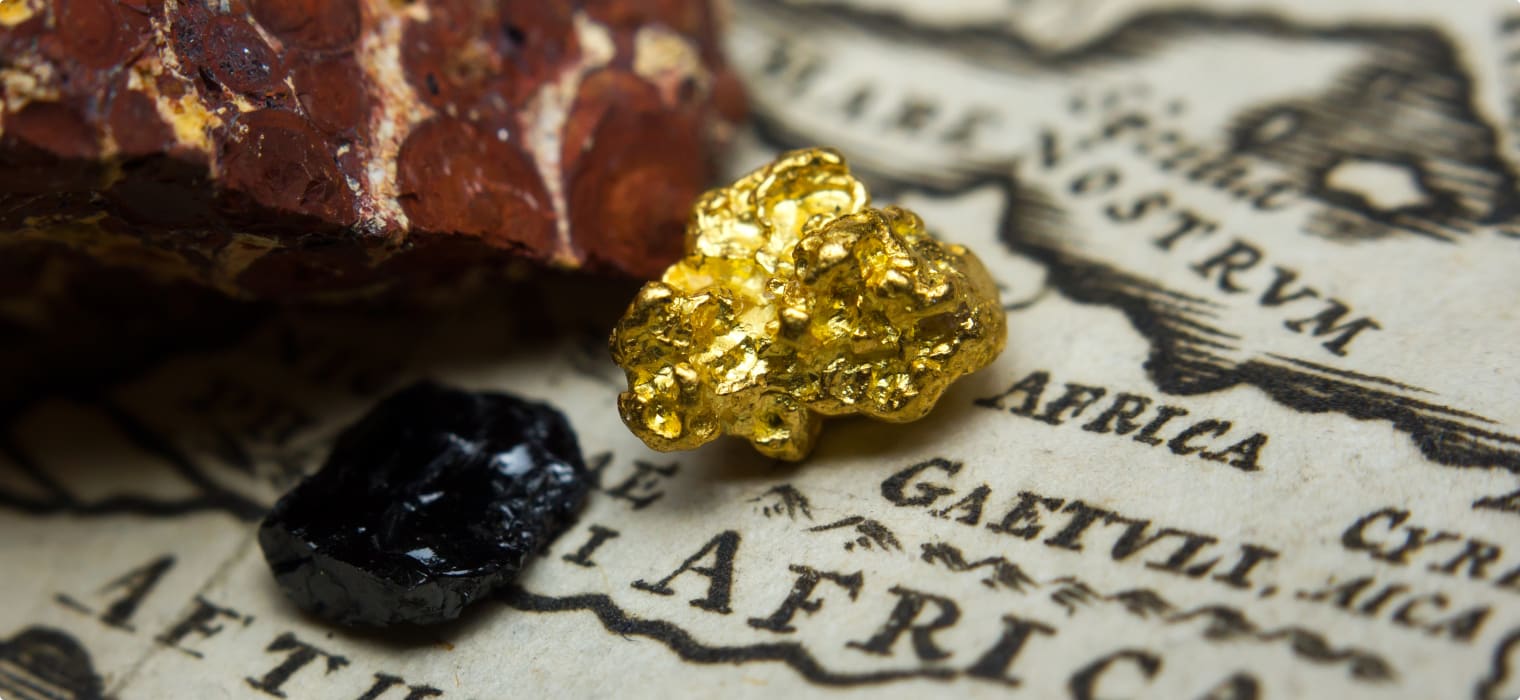
Africa’s Gold Coast and the Gold Trade
West Africa’s fabled ‘Gold Coast’, the former region on the Gulf of Guinea now known as Ghana, was once best known for its relationship with the expanding global money supply. Providing gold for the Atlantic trade from the 15th century, this was a spin off from an even older trade: the gold trade across the Sahara which had developed from the eleventh century onwards.
The arrival of the Portuguese on the Gold Coast in 1482, however, would mark the beginning of a transformative era for the region, significantly altering its social, political, and economic landscape. With the establishment of Elmina Castle, the Portuguese not only tapped into the lucrative Atlantic gold trade but also set the stage for a series of complex interactions between European traders and African states.
Until the middle part of the seventeenth century, the main aim was either to secure gold or to gain supplies of food that assisted in the overall trade. The Gold Coast region globalized very rapidly with this new direction. By the first decades of the seventeenth century, it had become a key site in European geopolitical competition.
By then the interplay between local rulers and foreign traders had fostered mutual dependencies and alliances, with European traders arming African allies in an attempt to gain a mercantile advantage, profoundly impacting the socio-political fabric of the region as a result. It was only by this later period that the trade in captives grew, and the character of the Gold Coast region completely transformed.
This article explores the history of the Gold Coast kingdoms’ trade in gold with European powers, and the transformations that occurred in the region as a result. It is intended as background reading for for Odyssey Traveller’s 21-day West Africa Tour: Ghana, Togo, and Benin. Much of the information is sourced from Toby Green’s A Fistful of Shells: West Africa from the Rise of the Slave Trade to the Age of Revolution.

Continues Below.
The Portuguese Arrival on the Gold Coast
In 1482, the Portuguese established Elmina Castle on the coast of present-day Ghana. This site would become a crucial trading post for gold as the arrival of the Portuguese triggered a surge in European demand for African gold that lasted until the 19th century.
For the Portuguese, however, initially getting permission from the ruler of Elmina, Kwamena Ansa, to build the fortress was a challenge. Elmina was under the authority of the powerful Eguafo Kingdom, and it is possible that Kwamena Ansa did not have the sole authority to make such a decision.
On the other hand, like many tributary kings in West Africa and the Americas at the time, Kwamena Ansa may have seen the Portuguese military power as a potential path to autonomy. Meanwhile, the Portuguese were eager to protect their gold- trading interests from Spanish rivals, who had fought them for control of the Cape Verde Islands in a series of conflicts in 1476–77. Ultimately, Kwamena Ansa agreed to allow the Portuguese to build the fortress on payment in exchange for a large payment of cloth, basins, and copper manillas.
However, the underlying issues of this exchange soon became apparent. For the Portuguese, the primary focus was the profits of the gold trade. They would quickly develop trading relations with numerous smaller states such as Abrem and Labadi, which traded in gold. For Kwamena Ansa and his people, though, the market was not the ultimate measure of value. Trade was embedded in a broader framework of belief and religious practice grounded in gift-giving exchanges, encompassing material and the non- material world.
When the Portuguese Captain Deigo de Azambuja selected as the site of the fortress the top of some high cliffs – held to be Holy and worshipped by the Africans – the locals erupted in anger and took up their arms. Gold Coast armies were formidable in the late fifteenth century, even before the introduction of guns. The Portuguese, outnumbered and hindered by damp gunpowder rendering their firearms ineffective, could not withstand the assault and were forced to retreat to their boats. Unable to resist, they were forced to take flight back to the safety of their boats.
Nevertheless, the inducements were such that the fortress was eventually built. Once established, it unleashed irreversible events, and within a few years, at least 170,000 dobras of gold were being despatched to Portugal annually.
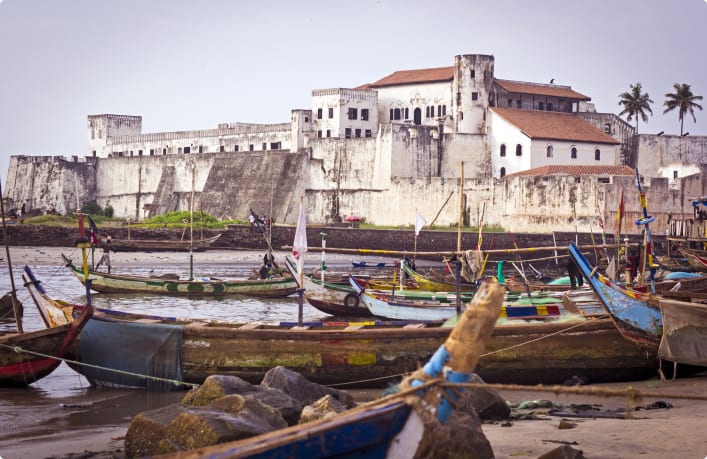
Political Contexts of the Early Exchanges
Throughout the sixteenth century, it was abundantly clear that the Portuguese depended on Gold Coast kings for their security. When the stronghold of Axim was constructed by the Portuguese in 1503, on the western stretch of the coast, it was said that, without it, their traders would have been at the mercy of the Africans.
By 1520, the Portuguese were recorded as frequently giving out gifts of cloths to local Assa and Akan kings. It was important for the Portuguese to keep these rulers on side, since, six years earlier, in 1514, the Assa king had fought with the Portuguese against the King of Fetu (Afuto), who had sought to destroy the settlement at Elmina. Thus, it was only by acknowledging African political control that the early Portuguese traders could protect their position.
Fetu’s power was constantly a thorn in the side of the Portuguese trading networks. Only by allying themselves with Fetu’s enemies could the Portuguese succeed. In a major conflict of 1577– 8, the Portuguese allied with the peoples around Elmina to defeat Fetu and their allies of Komenda, razing the towns and putting the people to flight; this was a significant episode, since Komenda had, over the past century, grown into one of the most important political forces on the coast. Thus, it was only through military alliances with local peoples that Europeans were able to secure their own networks
Other European powers, particularly the Dutch and English, soon began their own significant and organised trade in West Africa from the 16th and 17th centuries, which also depended on local alliances. In time, these alliances became of more than political significance to both sides. Cultures and ways of doing things changed, and each influenced the other.
Kings of the Gold Coast, for instance, adopted useful crops, expanding food production. The best example was maize, widely grown on the Gold Coast and, according to one 1572 account, imported from the Americas by the Portuguese through their settlement on the island of São Tomé. Known by the Fante as oborowi, or ‘millet from overseas’, by the early seventeenth century, it was found growing with many different colours, as, of course, had long been the case in Mexico. Meanwhile, it was not just gold that European traders brought back with them from the trading posts. Gold Coast handicrafts were also widely admired in Europe.
With the rise of state power, and the profits from the trade so essential in maintaining it, mistrust grew between Gold Coast and European partners. The mutual-aid agreements signed in the 1620s became rarer, as Gold Coast kings played off one European against another, the Dutch against the English or the Portuguese. The reality was that, until perhaps the 1680s and 1690s, all the cards were held by the Gold Coast kingdoms.
Akan States and the Europeans
Within ten years of the establishment of the Elmina castle, traders were coming from every corner to Elmina. From the Gold Coast region came traders from Abrom, Akan and Adanse; Mandinga traders travelled from the area near the Mali Empire; and Susu traders arrived from further west, near the Greater Senegambia region. They all hoped to trade their gold for fine cloths coloured red and blue, corals and copper manillas.
With the arrival of new routes for trade, therefore, the cosmopolitanism of the Gold Coast continually increased. Numerous small kingdoms, each with its own ruler, nobility, languages, and customs, were all eager to access the lucrative trade. Gold Coast rulers found themselves in an improved commercial position, strategically situated between major trading networks: the Atlantic and the Saharan. Political leaders could leverage these competing networks, both vying for access to gold, to ensure power remained with the local Akan states. In the sixteenth century, this region saw the rise of the powerful Kingdom of Denkyira, with Akan military and political power peaking around 1660.
Until later in the 17th century then, political power and decision-making remained in the hands of Gold Coast rulers. Local kings had major advantages that outsiders struggled to overcome. One was the disease environment, in which European traders fell like flies or spent long periods in bed fighting off death. But it was also very easy to assert local priorities because Gold Coast kings controlled the water supply, without which European factors and the ships they were charged with supplying could not operate.
The real source of control though was over the trade routes that brought the gold from inland, and over information. By the seventeenth century, European trading companies were reliant on their Gold Coast servants for precious news as to what the English might be lacking, or what the Dutch might need in order to trade successfully. Even when they had made alliances, this was dependent on African acquiescence.
By that time, the region’s gold had become crucial to expanding European empires, leading to increasing political and military pressure with demonstrably negative impacts. The Dutch United Provinces, for instance, relied entirely on gold from ‘Guinea’ to mint its currency in the seventeenth century. Similarly, between 1674 and 1714 England’s Royal African Company minted 548,327 guineas derived from gold mined in this region. The Portuguese, meanwhile, continued to demand gold to counter rampant inflation in their escudo currency.
Driving the African side of the trade was a strong demand for imported goods. The import of copper manillas to West Africa, where copper served as a significant form of currency and item for ritual exchange, facilitated growth by providing a more exchangeable currency. The trade proved highly lucrative for the Portuguese, yielding profits exceeding 500 per cent.
Both Akan and European rulers were, therefore, eager to expand trade exchanges to enhance market and state mechanisms. The process of exchanging gold for copper currencies was instrumental in expanding trade, but also had long term social, political, and economic implications.
Social Transformations of the Gold Coast Society
The surge in demand for gold on the Atlantic coast brought by Portuguese traders led to many social transformations. New trading towns emerged, and new routes were established to transport gold from the forests. Gold acquired multiple values beyond merely being a currency equivalent; it was also crucial as a symbol of display, social status, and ritual power, as well as an export currency.
Once it had begun, the rapid growth of coastal trade to and from the goldfields quickly brought about significant changes in Akan communities. By 1503, just twenty-one years after Elmina’s castle- prison was built, the association of the new faith of Christianity with this expanding prosperity was having a major impact. In August of that year, the kings of Akyem (Acomani) and Fetu (Afuto) came to Elmina to request baptism from the Catholic missionaries there.
There were, of course, political considerations for doing so, with the hope that an alliance with the Portuguese would bring military and political advantages and perhaps mitigate the growing power of the inland Akan kingdoms, where Denkyira was being formed at roughly the same time. But, beyond these pragmatic reasons, this willingness to adopt a new religion should be understood through the West African religious context, whereby the adoption of a new shrine and cult does not necessarily invalidate existing ones.
It is not surprising that local kings were open to a range of ideas, as distant influences had long been present in the region through itinerant Mandinga traders connected to the Mali Empire. Additionally, Islamic influence could be seen in the design of gold weights at this time.
The Portuguese trade further increased the cultural pluralism of the Gold Coast. By 1623, a Dutch ship captain described how the peoples living along the coast were amazingly varied, noting that every five or six miles a different group with completely different customs could be found. The Portuguese also introduced new fruits from Portugal, such as lemons, oranges, figs, and grapes, as well as maize from the New World.
Political Transformations
The political environment was changing too. Akan towns had likely been divided into abrons (wards) since the fourteenth century, and paramilitary companies known as asafos already existed. In the sixteenth century, as long-distance trade expanded, these patterns also grew. Urban areas thrived on the increasing agricultural surplus from the countryside and the boom brought by the new maize crops. Additionally, by 1580, taxes were being paid in gold to the burgeoning political establishment.
Towns and kingdoms increasingly competed for dominance and access to European trading goods. The patchwork of very small states such as Akyem and Assim that existed around 1500 gradually gave way to larger interior states that controlled the gold trade. Initially, Denkyira held this control, followed by Akwam. in the latter part of the seventeenth century, located far to the east of Denkyira, north of Accra. These states traded on the coast through Fante merchants, with Fante’s power growing significantly from the second half of the seventeenth century onwards.
The rise of the Atlantic gold trade was then by and large a period of growing, but unequal, prosperity. Wealthy men, known as the abirempon, expanded their riches through trade and built up retinues of followers. They often had many wives and maintained their social status through acquiring luxury goods through market trade. Meanwhile, at the ports, brokers known as the afahene controlled exchanges of gold with the European ships for basins, cloth, copper and cowries, which expanded the money supply and the market exchanges.
By around 1600, gold had become the standard unit of value, surpassing the worth of cloth or iron bars that were used at the same time. The adoption of gold as the standard along the Gold Coast played a crucial role in state consolidation and the development of new social control mechanisms. It expanded the tax base and currencies in use, thus broadening markets and enhancing local kings’ ability to develop their political infrastructure and invest in imported weaponry like muskets.
Economic Transformations
Economic transformations were seen in the increased competition for Akan gold. The immense demand from Dutch and Portuguese traders on the Gold Coast offered a ready outlet for the overproduction of gold from the Akan forests that was already apparent in the fifteenth century. However, as demand grew, it eventually began to outstrip the supply of available gold for export.
Gold was not only used as a currency on the Gold Coast, it was also used as ornamentation, with people wearing rings of gold around their necks. With gold used as a commodity and a store of power, as well as money, the amount available for export flattened off by 1600. Nevertheless, the number of ships coming to trade continued to increase all the time.
As a result, the prices of imported goods rose in the local currency. This price rise in turn led to the proliferation of different currencies and an increase to the overall amount of currency in circulation. There were simply more linen cloths, more copper, and more iron than ever before. There were also more raw materials for the smiths to fashion into ornaments, weapons and tools. This rapid expansion of materials meant that there was a growth in markets in this period, leading to more wealth for the abirempon, richer market towns on the coast and in the interior, and enhanced state capacity to grow through the extraction of a tax base.
From Saharan Empires to the Atlantic
By 1500 the kingdoms along the Gold Coast had found themselves in between the Atlantic and Saharan empires. As well as trading with Europeans for Atlantic goods, they also participated in the trans-Saharan trade network, connecting West Africa with North Africa, as they traded with such Sahelian empires as Mali and Songhay.
However, this intermediary role between the Atlantic and Saharan empires soon changed, as the Songhay Empire weakened and eventually collapsed in 1591. As the centre of political power in the Sahel moved east, to Kano and Borno, this was to have significant consequences on the Gold Coast, which was no longer able to occupy a buffer zone between imperial systems as it had been throughout the sixteenth century.
Consequently, as the 1600s progressed, disruptions in the trans-Saharan trade routes caused by the decline of powerful Sahelian empires made the Atlantic trade routes more attractive and reliable. As a result, states closer to the Atlantic, like those on the Gold Coast, increasingly integrated into Atlantic trading systems.
This shift was decisive in the political changes that began to take place along the Gold Coast towards the end of the seventeenth century, as the European presence became militarized through the fortress enclaves that sprang up along the whole coast after 1640. European trading nations engaged in a free-for-all to form local alliances, rent land from kings, and build fortified trading posts.
The European fortresses were stark reminders of African kings’ and traders’ dependence on European nations for the firearms essential to their military strategies and defence. They fortresses were deliberately built to be imposing and to suggest a challenge to traditional African political control on the Gold Coast. They also reflected the commercial rivalries and attacks by European on one another to try to secure trading hegemony.
Akan traders frequently exploited these rivalries to secure better terms. However, the constant import of firearms and competition among African and European rivals fuelled disorder, which the militarized forts exacerbated. By the end of the 17th century, the numerous small kingdoms on the Gold Coast were breaking out into nasty, short wars. These conflicts would eventually lead to the emergence of the larger states of Asante and an expansionist Fante Federation in the eighteenth century.
European traders persistently sought to manipulate these wars, supporting one side or the other in the hope of increasing the number of enslaved captives available for sale. This eagerness was driven by a growing slave trade, which had begun to supplement the longstanding gold trade by this time.

The Rise of the Slave Trade
In 1595, the island of São Tomé witnessed a major uprising of enslaved Africans. At the time, the island, a Portuguese colony, was an important centre for sugar production, which relied heavily on the labour of enslaved Africans
Although São Tomé lay a long way offshore from the Gold Coast, in the Gulf of Guinea, off Central Africa’s Atlantic coast, the upheavals still mattered a great deal to the communities on the Gold Coast. Already by 1595, São Tomé had been linked with the Gold Coast for a century through the provisions trade, which had in time brought maize and manioc from Brazil to West Africa, and as a supplier of enslaved persons who came from Benin and Kongo to work at the fortress of Elmina.
Not only did the uprisen Africans decimate the sugar plantations on São Tomé, but this was swiftly followed by the rise of a parasite that infested the cane. The sugar industry on the island collapsed, exacerbated by competition from Brazil. As a result, São Tomé slave traders began to focus more on the trade to and from the neighbouring coast; beginning in Allada, east of the Gold Coast, this trade would before long begin to have an impact in the traditional gold-exporting areas of the coast
Initially, the growth of the trade in captives at Elmina itself was limited by laws passed by the Portuguese and then the Dutch banning this 10 leagues either side of the castle. By 1620, Portuguese factors had urged the king to lift this ban, to no avail initially. Nevertheless, by the 1640s, the logs of the Dutch factors at Elmina made it clear that the trade in enslaved persons had grown rapidly in the neighbouring regions and was beginning to affect relations on the Gold Coast itself.
This was part of a major growth in English slave trading across West Africa, from Sierra Leone to Cameroon, which went with the rise of sugar plantations in the new English Caribbean colonies. Indeed, in these years, the English trade was almost exclusively for enslaved persons, whereas the Dutch traded for gold as well as for labour of captives in their plantations in Brazil.
By the later seventeenth century, these changes would have notable effects on the political conflicts in the Gold Coast region. Denkyira’s decline can be seen in the way in which some of their soldiers were kept as ‘pawns’ (hostages) in English forts by the 1690s – some of whom could later be converted into ‘capital’ and sold into the transatlantic trade if debts were not repaid. Many of the pawns at this time were canoemen from the coastal regions, whose work panning for gold was perhaps no longer so profitable, since greater profits could be wrought by using them as collateral for the trade in captives. And so, gradually, the incessant demands from the New World for labour had visible political and social effects on the Gold Coast.
Small Group Tour of West Africa for the Adventurous Senior Traveller
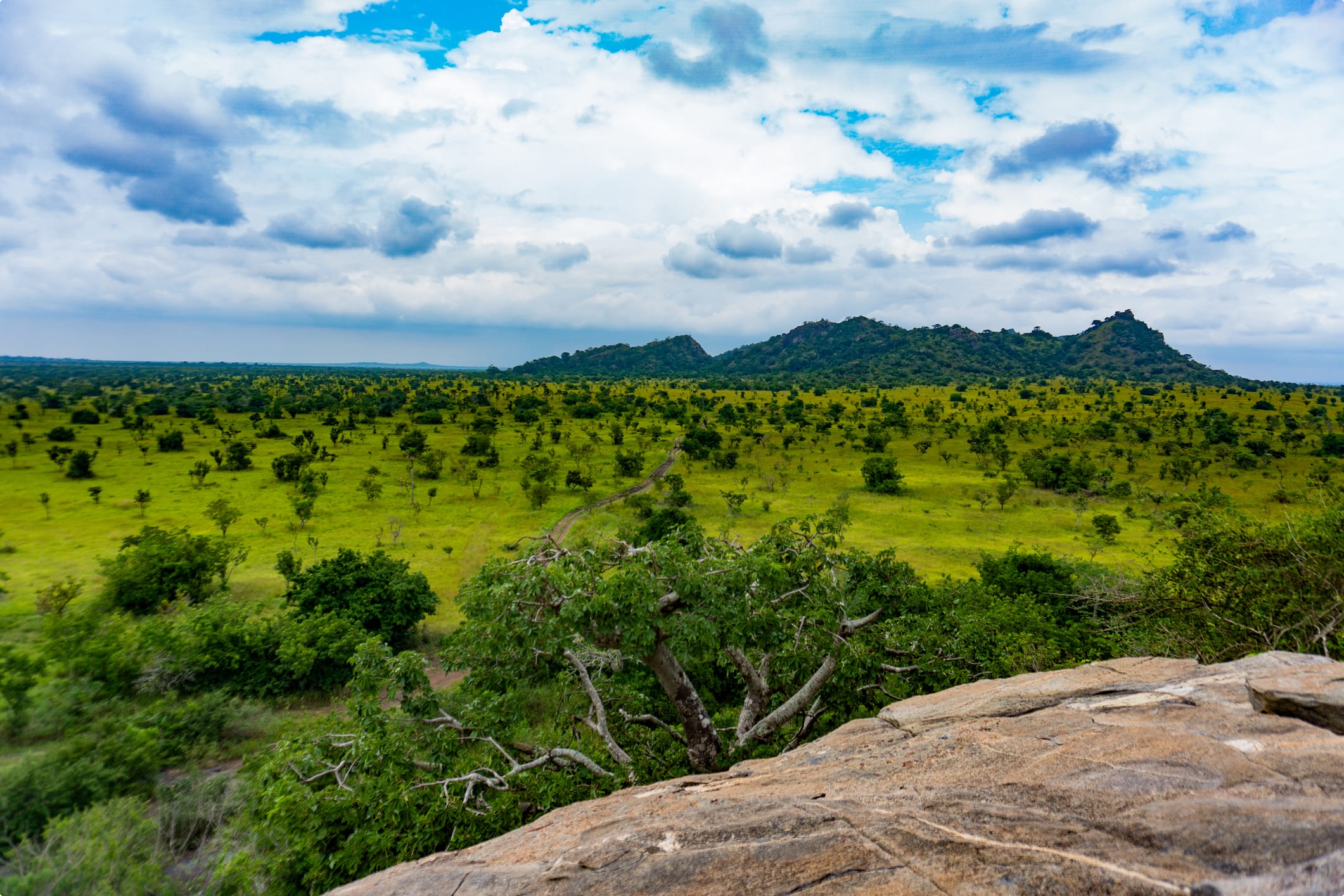
Odyssey offers easy, convenient, and relaxed escorted small group tours across the world, including to Ghana, Togo and Benin in West Africa. On our 21-day small group tour West Africa, we explore these three countries’ natural beauty, ancient heritage, World Heritage Sites, and famous cities, all with some truly spectacular scenery along the way. Ghana, Togo and Benin may be off the usual tourist route, but each has much to offer the discerning visitor. Our tour concentrates on the history, culture and wildlife of these African countries. Designed for the senior traveller, It is led by experienced, and enthusiastic likeminded tour leader and guides.
This small section of Africa has a fascinating, if often tragic, past. Colonial powers including the Portuguese, French, Germans and British all fought for control of this gateway into the rich African interior. It was from here that enormous numbers of slaves were shipped to Europe and the Americas from the 16th to the 19th century. On our tour we will visit some of the well preserved “Slave Castles” to witness this infamous part of European history.
The pre-colonial past is also fascinating. Local kingdoms existed from very early times. Our trip explores the culture and history of a number of different groups. In Benin, for example, we will visit the mud tower houses of the Batammariba people. Take time to trace the history of Somba culture in the Natittingou Museum. A Gelede masked dance ceremony will give us an insight into local traditions dating back to the 15th century.
Ghana, Togo and Benin offer a diverse range of cultures and activities in what is actually quite a small region. There are long, palm fringed, sandy beaches, dense rain forests, teeming cities and exotic wild life parks. These countries all suffer from great poverty but each is attempting to escape from their economic hardships through a variety of strategies, including increased tourism. Become a part of the solution!
Odyssey Traveller has been serving global travellers since 1983 with educational tours of the history, culture, and architecture of our destinations designed for mature and senior travellers. We specialise in offering small group tours partnering with a local tour guide at each destination to provide a relaxed and comfortable pace and atmosphere that sets us apart from larger tour groups. Tours consist of small groups of between 6 and 12 people and are cost inclusive of all entrances, tipping and majority of meals. For more information, click here, and head to this page to make a booking.
Articles about Africa published by Odyssey Traveller:
- The Portuguese in Africa
- Discover Central and West Africa: Ghana, Togo, Benin and more
- Exploring South Africa: The Definitive Guide for Travellers
- Madagascar’s Fascinating History
- Questions About Egypt for Senior Travellers
- West African Gold and Empires
For all the articles Odyssey Traveller has published for mature aged and senior travellers, click through on this link.
External articles to assist you on your visit to West Africa:
Related Tours
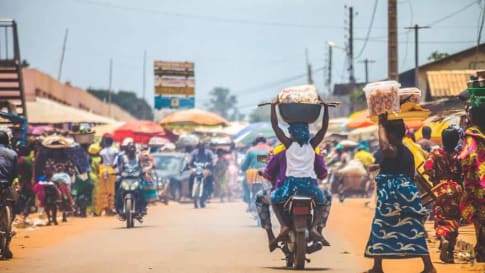
21 days
May, SepExplore the History, Culture & Wildlife of West Africa: Ghana, Togo & Benin
Visiting Benin, Ghana
This small group tour for couples and solo travelers concentrates on the history, culture and wildlife of coastal Central Africa. Meet the friendly local people and come to a greater understanding of just what has made them what they are today.
From A$14,995 AUD
View Tour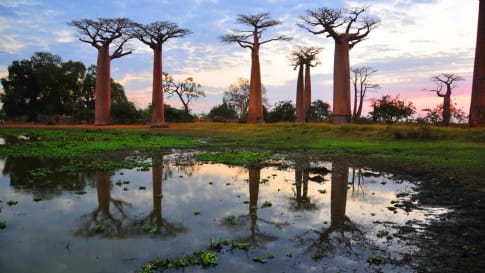
16 days
Apr, Aug, SepMadagascar Small Group Tour | The island of Lemurs & Avenue of Baobabs
Visiting Madagascar
On this small group tour we explore the country’s natural wonders as well as its colonial past. Madagascar has a range of extraordinary plant and animal life which we will have the chance to view in the island’s National Parks and Nature Reserves. While on the tour we will also learn about both the Portuguese and French periods of control.
From A$14,295 AUD
View Tour
10 days
SepNamibia Wildlife and Culture Tour for Seniors
Visiting Namibia
A small group tour for seniors and couples to Southern Africa for couples and solo travellers. Namibia shares borders with Angola and Zambia to the north, Botswana to the east and South Africa to the south and east. Wedged between the Kalahari and the South Atlantic, Namibia is home to the oldest desert of the earth. Despite its parched reputation, Namibia is one of the world’s best wildlife destinations.
From A$11,695 AUD
View Tour
19 days
AugSouthern Africa Tour | Fully Escorted Africa Tour for Seniors
Visiting Botswana, South Africa
Experience as a small group tour for couples and solo travellers, the beautiful landscapes of the Garden route and the unique wildlife at places such as Kruger National Park, Cape Town, Victoria Falls and Chobe Game Reserve. During the program participants will have the opportunity to learn about the culture, the politics and the social issues facing South African people in Soweto and more. How the natural resource managers are caring for their wildlife reserves in the face of land enclosure, climate change and poaching.
From A$12,095 AUD
View Tour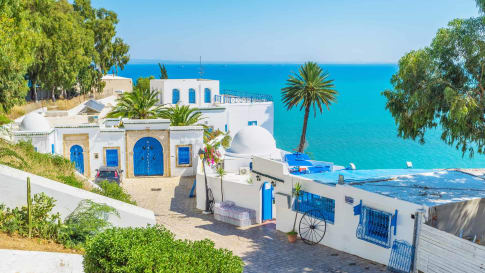
14 days
Apr, Sep, MarTour of Tunisia
Visiting Tunisia
Join Odyssey Traveller on this small group tour of Tunisia in North Africa for couples and solo travellers, where Carthaginian ruins sit side by side with Roman monuments, grand Islamic mosques, Arabic souks and medina, and honeycomb-like Berber cave dwellings and hilltop villages.
From A$10,995 AUD
View Tour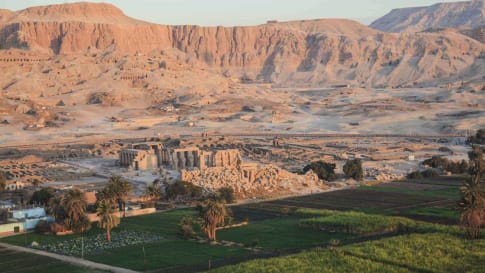
18 days
Nov, JanEgypt tour: escorted small group history & cultural tour of Egypt
Visiting Egypt
Our small group program for senior and mature couples and solo travelers takes us to contemporary feats such as the Aswan Dam and also to current crucibles of the Egyptian experience such as Tahrir Square. Proof, were it needed, that Egypt’s role as the pivot of civilisation is far from ended. There is the opportunity to visit our Morocco, Jordan or Iran tours before embarking on this tour of Egypt.
From A$12,950 AUD
View TourRelated Articles

10 Unimaginable Destinations: The Definitive Guide
Experience and knowledge shows that they are plenty of places in the world still to be explored by the curious. Our collection of small group tours for seniors as well as mainstream tours to France or Italy can take the traveller as a couple or solo traveller to places of curiosity such as Panama or Iran the list is endless for the curious.

Atlantic Triangular Slave Trade
Atlantic Triangular Slave Trade Somewhere between ten million and twelve million enslaved Africans were transported across the Atlantic to the Americas between the middle of fifteenth century and the end of the nineteenth. The largest…

Birth of the Nile River
The Nile, one of the world's great river systems for trade and agricultural production. Learn more about the river and its journey our across Egypt. An Antipodean travel company serving World Travellers since 1983 with small group educational tours for senior couples and mature solo travellers.

Caesar and Cleopatra in Egypt
Learn about the Roman Emperor Caesar exploring Egypt and the historians interpretation of the relationship with Cleopatra. An Antipodean travel company serving World Travellers since 1983 with small group educational tours for senior couples and mature solo travellers.
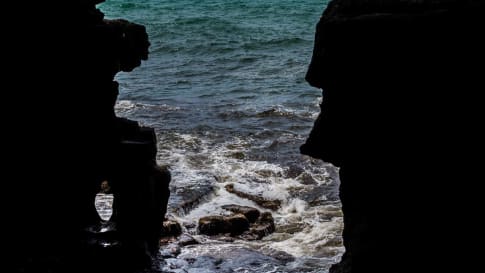
Caves of Hercules, Morocco
Visit the cave of Hercules whilst on a Small group package tour of Morocco for mature and senior travellers. Morocco is an ancient country with a fascinating history too be explored by couples and single travellers.

Continental Crossroads: Discover Morocco
Morrocco, ancient civilisation, blue city, white city, Berbers, The Romans, Portugese the history rolls on for this country in North Africa. Join a small group vacation package that tours Morocco. A tour of Morocco for mature and senior travellers, couples or singles over the course of the itinerary, the history, culture and landscape are all explored, from Fez to Marrakech or the Cave of Hercules.

Discover Central and West Africa: Ghana, Togo, Benin, and more
Central and West Africa has a rich and vibrant history, that is rarely properly explored. Odyssey provides a number of tour packages to Africa, with trips that include South […]
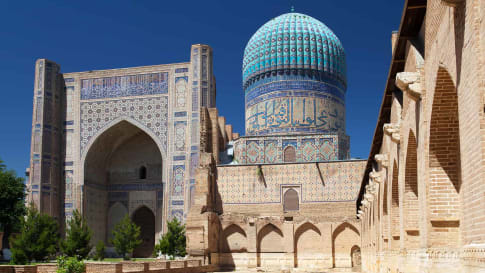
Elements of Mosque Architecture
The word "mosque" often brings to mind not this simple prayer space, but the ornately decorated monuments built by powerful Islamic rulers.

Exploring Southern Africa: The Definitive Guide for Travellers
Exploring Southern Africa Southern Africa, a subregion of the African continent, is composed of Angola, Botswana, Lesotho, Malawi, Mozambique, Namibia, South Africa, Swaziland, Zambia, and Zimbabwe. (The United Nations geographic region of Southern Africa, on…

Madagascar’s Fascinating History
Madagascar’s Fascinating History Geographically remote, off the eastern coast of Africa and in the Indian Ocean, is Madagascar. This article briefly outlines the history of Madagascar and examines the unique biodiversity of the island. Baobab…
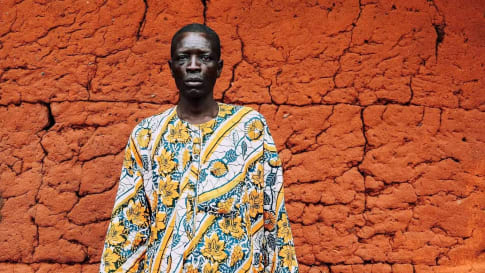
Portuguese in Africa: The Definitive Guide
The Portuguese in Africa The Kingdom of Kongo and the Transatlantic Slave Trade The Kingdom of Kongo was a former kingdom that dominated West Central Africa in the fourteenth century (Heywood, 2009). Located south of…
